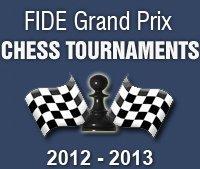
Decisive Results Abound in Round 1 of U.S. Championships
Decisive Results Abound in Round 1 of U.S. Championships
By FM Mike Klein
SAINT LOUIS, May 8, 2012 -- There were running starts and standing starts and very little in between to open the 2012 U.S. Championship and U.S. Women's Championship. All but three games in the events produced a decisive result. The tournaments are being hosted by the Chess Club and Scholastic Center of Saint Louis for the fourth consecutive year.
In a turn of the unexpected, the grandmasters in the U.S. Championship played more provocative chess than their female counterparts. Their early imbalanced positions meant the first three games to finish came from their event.
The first result shocked everyone. GM Alex Stripunsky overlooked a simple capture on move 11 and resigned immediately against GM Alexander Onischuk. According to U.S. Championship statistical guru Ed Gonsalves, the game was the third shortest to produce a winner since the modern tournament began in 1936. Onischuk felt some of his playing partner's chagrin and was disappointed with the way he won. “We are really good friends, and I feel sorry for him,” Onischuk said.
Several other players offered various possible reasons for the blunder, but at the end they were simply left guessing. Onischuk took a walk with Stripunsky afterward but could only speculate on whether Stripunsky could recover mentally. “It depends on the personality,” he said. “Some people will never recover.” The loss is particularly handicapping for Stripunsky, as he squanders one of the cherished opportunities with the white pieces. Onischuk's good fortune allowed him to be the only player to win as black in either championship.
Top-seeded GM Hikaru Nakamura scored the second point of the day by converting an opening advantage against GM Robert Hess. Nakamura skipped last year's championship and came prepared this time, opening with 1. e4 and making his unsuspecting opponent think on move one. Hess took three minutes before playing his usual 1...e5 but the next surprise lurked only a few moves later when Nakamura played 4. b4, the Evans Gambit, an opening only a shade younger than the incorporation of Saint Louis as a city.

“I just felt like trying something new,” Nakamura said. “It's almost like when [Nakamura] plays 1. e4, you know he's got something up his sleeve,” said Jennifer Shahade, one of the two on-air commentators. Nakamura questioned 9...Ba3, which was only played one other time in 1967. Hess was attempting to free his light-squared bishop and give back his extra pawn, but Nakamura suggested 9...b6 as a possible improvement. Hess said he was weary of playing a more topical variation against the Evans, especially since he had not studied the opening in a long time. He added that while his 12-page college paper analyzing the writings of Jorge Luis Borges was turned in prior to the game, that was not an excuse for his theoretical shortcoming. “Nakamura is so hard to prepare for anyway,” Hess said. “I lost because he completely outplayed me.”
Defending champion GM Gata Kamsky finished next, besting tournament newcomer GM Alejandro Ramirez. Kamsky played in the style that has allowed him to elude defeat for the past several U.S. Championships. “My style of play is called constrictor,” Kamsky said. “I'm a great admirer of (former World Champion Tigran) Petrosian. He came up with that style of play.” With Ramirez's backward pawn on d6 sitting helplessly, Kamsky marshaled all of his pieces into position, then pushed a pawn one square on the edge of the board. The move was cunning in its subtlety, and Ramirez admitted that he could not find a good move afterward.
In other round one action, two of the younger players squared off. GM Alex Lenderman played the most attacking-minded game against GM Ray Robson. He got a pawn to f7 early, opened the file his opponent's king sat on, and jettisoned a piece into the foray to gain time for the whirlwind. Robson complicated the issue by walking his king to f6, an unexpected maneuver for Lenderman. “It's such an unusual idea,” Lenderman said. “I just didn't see it. I kind of underestimated it.
“I was actually trying to steer the game away from dynamic complications, but Ray went for it, so I had to. I'm a little surprised I won this game.” Robson survived until the endgame, when Lenderman claimed he won by a single tempo.
In their first-ever meeting, GM Varuzhan Akobian and GM Yasser Seirawan faced each other. The two are at opposite ends of their chess careers. Akobian is seeking his fist U.S. Championship title and a return to qualifying for the U.S. national team, while Seirawan already has a handful of titles and has returned after a long layoff to play in the tournament for the second straight year. Like 2011, he got off to a slow start, as Akobian edged him out today. “Somehow I was slipping, and I just couldn't stop slipping,” Seirawan said. Akobian's pieces overwhelmed his opponent's, but the timing of when to convert his activity into a material advantage was crucial. “I was better,” Akobian said. “But you never know if you win the pawn, if you're going to win the game.” Still, his position was devoid of risk, and allowed him to ease his way into the tournament. “I was definitely enjoying the position.”
GMs Yury Shulman and Gregory Kaidanov played a see-saw affair that ended in the only draw of the championship. “I'm sure Yury was worse,” Kaidanov said. “I just couldn't find ...” and the end of his sentence was as elusive as the clinching move of the game.
In the U.S. Women's Championship, reigning champion IM Anna Zatonskih began her title defense with a painless win over 17-year-old Alena Kats, who is playing in her first championship. Zatonskih had the classic dominant knight against an imprisoned bishop, and a stranglehold of both sides of the board. “She probably doesn't have experience in such positions,” Zatonskih said.
Kats said preparing for Zatonskih is mostly guesswork. “I was expecting anything really,” she said. “Maybe I don't know anything?” Zatonskih jokingly replied. “I'm just playing!”
IM Irina Krush, who since 2006 is the only other woman to win the event besides Zatonskih, kept pace with a convincing win over WGM Sabina Foisor. The two also played in the first round last year, when Krush survived an onslaught only to hang her queen and scramble later in the tournament to try to qualify for the finals. Besides getting off to a better start, Krush was particularly pleased with the planning that helped her win the game.

“All these ideas I studied I actually got to use,” she said. “It was a product of all my work. The onus is on white when black plays ...g6 lines.” Krush liked her early a4 and was ready to push the pawn again to restrain the knight on d7. She gave back her surplus pawn at just the right moment, then in a better position found a knight retreat that forked Foisor's rook and bishop. She admitted that it took her a few minutes to find the elementary idea, but was completely satisfied with the quality of her play.
IM Rusudan Goletiani came out of an equal middlegame to land a dominant queen in the center of the board. WGM Camilla Baginskaite could only wait, and Goletiani's kingside pawns marched up the board and then used her queen for an indefensible pin to net a piece and the game. Goletiani was rooted at her own board and was one of the few players who did not even know about the 11-move game in the U.S. Championship. “I guess I don't get as bored as other players,” she said.
FM Alisa Melekhina reversed an unfortunate trend by drawing WIM Iryna Zenyuk, whom she had lost to at three consecutive championships. She actually came close again. Melekhina pitched her weak isolated pawn but received insufficient counterplay, eventually scrambling for a pawn-down ending with queens still on the board. Zenyuk couldn't create a passed pawn without uncovering her own king. The two settled for peace after Melekhina's queen chased Zenyuk's king in the latter's fruitless search for shelter.
The last game to finish was WIM Viktorija Ni's unlikely draw of WGM Tatev Abrahamyan. Ni found herself down two pawns in the endgame after Abrahamyan's Benko Gambit netted her the typical control of the b-file and subsequent rook invasion. Both women ran short of time and Abrahamyan faced just enough difficulties to have the win elude her.
Round two begins 9 May at 1 p.m. Central, 2 p.m. Eastern. Tune in to www.uschesschamps.com for live commentary from Shahade and the club's GM-in-Residence, Ben Finegold. Pairings for round two can be found at www.uschesshcamps.com/standings-and-games.
.
Photos: Studio 314
